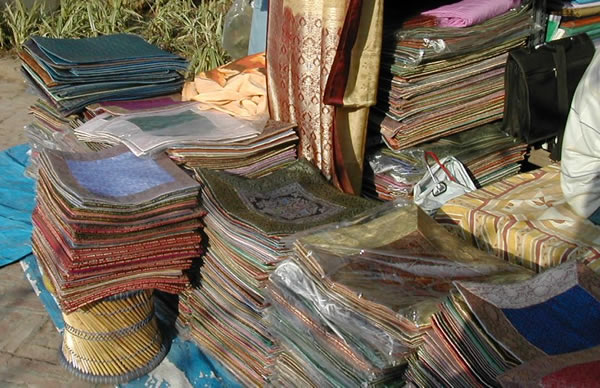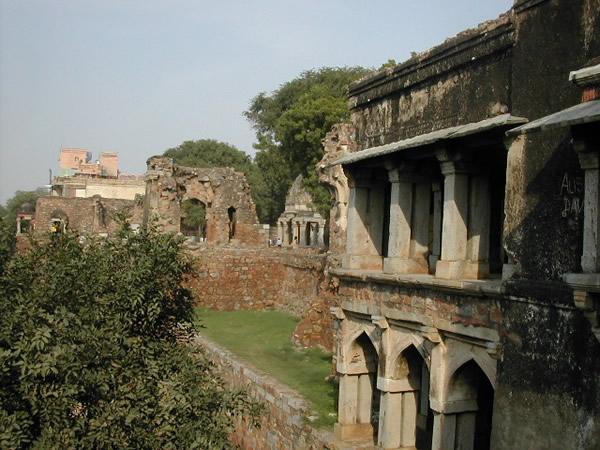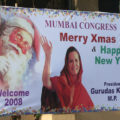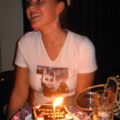My trip to India was short – too short. I arrived in Delhi at 12:30 am on Thursday, October 28th, crashed at a hotel for a few hours with my classmate Fiona, then at 6:55 am we hopped on the train to Dehra Dun (where we met lots of other Woodstockers). From Dehra Dun we took a taxi to Mussoorie, arriving at our final destination around 3 pm. After that it was non-stop, very intense reunion until Monday morning, when the bulk of our class left again in buses. Anne (escaped from Afghanistan) and I had a leisurely day around the school and took the train back down Monday evening, arriving in Delhi at 11 pm, where we joined Marilyn in a room at the Park Hotel, just off Connaught Place (very central).
As planned, we spent Tuesday and Wednesday shopping. I have a new house to decorate, remember, and India is the perfect place to buy wonderful fabrics at ridiculously low prices. I also had a specific assignment fromRossella, who wanted to decorate her room in bright pinks.
We went first to Fabindia, a name familiar to me from school days, when my roommate Lauri used to get curtains, cushion covers, etc. there to decorate our dorm room. I did not know until recently that the company was founded by an American, and its only branch outside of India (so far) is in Rome. Fabindia deals in hand-loomed and hand-decorated fabrics, mostly cotton and using natural dyes, with lots of detailed handwork such as embroidery and appliqué.
My classmates, knowing what I’d be up to in Delhi, had given me a gift certificate for Fabindia: 2000 rupees, = $45. This may not sound like much, but it went a long way: I got a new cotton bedspread for our master bedroom, in shades of pale blue and green to go with the peacock batik hanging over our bed; placemats-and napkins, oven mitts, apron, etc., all in yellow to go with our new yellow kitchen; a tablecloth for a gift; some cushion covers; and I don’t remember what else.
I had arranged with Uday Tour to have a car with driver for both days in Delhi, at US $35 per day. Yes, it’s possible, and probably cheaper, to grab taxis as you go, but it would have added considerably to the hassle factor. With your own car, you can leave your shopping in the trunk (or boot – Indians use the British term) as you go from place to place, rather than carrying it around. And you don’t have to haggle with taxi drivers at every stop. Even with your own A/C (air-conditioned) car, just getting around Delhi is tiring. With the new metro and constant road-building, traffic has improved, but is still bad enough, and distances are large, or at least seem that way. It’s stressful riding, partly because most drivers seem to lean on the horn all the time. I caught one of ours beeping when there was no comprehensible reason to do so – he was making a turn from a clear lane into a clear lane, and I couldn’t see anybody in his way. I think it was just force of habit. The blare fades into the subconscious after a while, but I still found it tiring.
When we had finished about two hours of looking at all the four or five Fabindia stores in Greater Kailash I N Block (this is a Delhi street address), with a rest stop for some very decent coffee and a glance into the other stores in the block, we piled our purchases in the boot and headed for our next destination: Dilli Haat (photo at top of page), a sort of idealized fake village/market with booths selling crafts and food from all over India, and occasional live performances.
The quality here is not so great, and you have to bargain to get justifiable prices. I ended up buying only a couple of things whose quality I did approve of, but I won’t give details here since they are Christmas presents for some readers of this newsletter! We did have a nice lunch of dosas – I was greedy and ate two, for about 50 cents each.
After that we were tired and went back to our hotel. Marilyn and I walked across the street to Jantr Mantr. This was more difficult than it sounds: we had to cross a big road in fast-moving traffic. Delhi is not well supplied with crosswalks or pedestrian crossing signals, so you often have no choice but to take your life in your hands and dash across, like everyone else does. Remember that they drive on the left; in a tired moment I made this elementary mistake, and almost got hit by a bus. Delhi doesn’t have those helpful “Look Left” and “Look Right” instructions painted on the sidewalk like they do in London.
I had not been to Jantr Mantr in about 25 years, and was sad to find it degraded, much of the marble eaten away by pollution and defaced by graffiti. It’s a protected park, but cheap for Indians to enter – Rs. (rupees) 5, or 10 cents, as opposed to the Rs. 100 that foreigners pay. Because it’s cheap and central and has lots of secluded niches, it’s a sort of lovers’ lane for young Delhi-ites. Which would be fine if they didn’t feel the need to declare their love by defacing the monuments.
In spite of the decay, Jantr Mantr is still a wonderful place to take pictures, especially in the soft evening light with the birds circling and swirling as they chose their perches for the night.
From there we walked to Jan Path, the kingdom of kitsch – very tiny shops selling all sorts of wonderful cheap junk. The sidewalks and plazas are crowded with human traffic, much of it trying to sell you something. That, plus the near-total darkness after sunset around 5:30 pm., made strolling around in Delhi more intense than I recalled or was prepared for. We made a quick trip to the handmade paper store on Jan Path (more presents), found Marilyn the burfi (a milky Indian sweet) she had been craving, and went back to the hotel.
We had let the car go for the day, and none of us felt like hassling with much of anything, so we elected to eat at the Park Hotel’s own Fire restaurant, offering “Indian specialties with a twist.” And so they were. I had a non-veg tandoori sampler, Anne had mutton (actually, goat) biryani, Marilyn had tandoori chicken with coriander. Everything was elegantly served and very tasty. The multi-layered glass partition separating the Fire restaurant from the Agni bar next door is etched with flame shapes, so the constantly-changing lighting from below creates a pleasing effect of multicolored flames leaping.
Marilyn left at 11 pm for her 2 am flight (most intercontinental flights out of India depart after midnight). Anne and I slept the sleep of the justly shopped-out.
The next morning we met our classmate Yuti in the hotel lobby at 10 am for the next bout of shopping. My classmates had also given me a beautiful silver bracelet, which I wanted to get adjusted as it was just big enough to slide off my hand. We walked to a nearby jewelry store in Jan Path, but they were not interested in the work. We then walked a couple of blocks on Connaught Place, but everything was still closed. Anne and Yuti remembered that the Central Cottage Industries Emporium, at the other end of Jan Path, would be open, so we walked there, accosted by touts all the way. Yuti says that Mumbai does not have these annoying guys trying to sell you things everywhere; next trip, I’ll do my shopping in Mumbai.
Cottage Industries, a government-run emporium, was drab and uninteresting 25 years ago, but has improved over time (and in the face of competition). It’s a huge, confusing building of about six stories plus mezzanine levels, offering handicrafts from all over India divided among categories (cushion covers, clothing, curtains, etc.). In each section, you select your purchases and receive a bill. This is convenient, because you don’t have to carry stuff all over the store, but also dangerous, because you don’t know how much you’re spending as you collect your sheaf of bills here and there. In the end you pay for everything at once at a central counter, and pick up all your bagged purchases at another counter.
I went crazy in there. For about $300 total, I got cushion covers galore, a hand-embroidered silk panel that I’m using to cover the open closet in my studio (the most expensive thing I bought that day, it cost Rs. 3850 – $85), cloth to make a curtain for the other open closet (in the den), bangles, bindis, various stuff for Christmas presents, and I forget what all else.
Hauz Khas
When that orgy of shopping was done, we called our car from the hotel nearby, loaded in everything, and took off for Hauz Khas, a shopping area built next to a beautiful Mughal ruin. Here we had an excellent lunch, includingbhindi (okra), which never tastes as good outside of India, and eggplant. We shopped around the area (scores of small shops, including some interesting Indian clothing designers), and I managed to find some more pink stuff for Ross, including a bright magenta rattan roll-up mat with a gold border.
To my great delight, we also found someone to fix my bracelet. He worked outside a jewelry store, but had gone for lunch when we were first directed to him, leaving several bulky items of gold jewelry on his unattended stand. Yuti said, “That can’t possibly be real gold, otherwise he wouldn’t have left it like that.” Turned out it was; when Yuti asked him about it, he explained that someone in the store was watching the whole time, so there was no danger of a thief walking off with the gold.
He shortened my bracelet, and also set the stone in my engagement ring. I had lost the original sapphire a few years ago, bought an emerald ($100) to replace it on my previous trip to India in 2002, but had not got around to finding someone in Milan to set the stone – the one place I had asked refused, saying the stone was too big for the setting.
This guy was happy to do both jobs, though he did have to stretch the prongs on the ring to fit the emerald, which is taller than the sapphire was. For extra security, he superglued it on the back. [later – Unfortunately, it didn’t hold – the stone fell out and got lost within a month.] Both jobs together took about half an hour, and cost the princely sum of Rs. 100 ($2). He might have charged more if I hadn’t been accompanied by Yuti – maybe a grand total of Rs. 200. Both processes were interesting to watch:
shot Nov 3, 2004, 2:29 mins
We were still lacking one critical item: organdy material for curtains for Ross’ room. This sheer, colorful material is widely available in Italy, imported from India at obscenely high prices. Surely I could find it cheaper in India? We asked advice of one of the shop owners in Hauz Khas, and were directed to Jagdish Store, in Lajpat Nagar – fortunately, more or less on our way back to the hotel. It took some time to find the store, find the cloth I wanted, and actually pay for it and receive it, and we were all already tired, but Anne and Yuti were magnificently patient about it, and I got some gorgeous magenta organdy material criss-crossed in gold, which will look very nice on Ross’ windows. Can’t remember right now what I paid for it, but it was a lot cheaper than it would have been in Italy.
And that did us in on the shopping. We went back to our hotel and collapsed for a while, brooding over election results, until it was time to join Yuti and her husband for dinner at a nearby pub restaurant. I packed my suitcases, and was dismayed to find that I still had room left in them – I could have bought more! I was tempted to go back for cushions to fill all the cushion covers I’d bought – in Italy, naked cushions will cost far more than the magnificent covers did in India. But I was just too tired, so my suitcases remained flabby, and I am short on Christmas presents. Damn. Next time I need to remember that I need at least three days for shopping.






